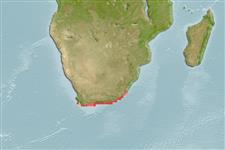Teleostei (teleosts) >
Ovalentaria/misc (Various families in series Ovalentaria) >
Pseudochromidae (Dottybacks) > Congrogadinae
Etymology: Halidesmus: Greek, als, alis = salt + Greek, desmos = link, bond (Ref. 45335).
More on author: Günther.
Environment: milieu / climate zone / depth range / distribution range
Ecology
Marine; demersal; depth range 0 - 16 m. Subtropical; 31°S - 35°S
Southeast Atlantic: False Bay, Cape Province to Coffee Bay, Transkei in southeastern Africa.
Size / Weight / Age
Maturity: Lm ? range ? - ? cm
Max length : 20.0 cm TL male/unsexed; (Ref. 4395)
Dorsal spines (total): 1; Dorsal soft rays (total): 58 - 63; Anal spines: 0; Anal soft rays: 48 - 52; Vertebrae: 66 - 69. Light to dark brown with color, sometimes with dusky crossbars (Ref. 4395). Middle lateral line joining with the dorsal lateral line just above the pectoral fin base; midline of parietal canal with a single pore; dark spot above pectoral fin (Ref. 531). Pelvic fin rarely absent; dorsal and anal fin membranes united only basally to caudal fin (Ref. 49841).
Common in intertidal pools and marginal subtidal areas (Ref. 4395).
Life cycle and mating behavior
Maturities | Reproduction | Spawnings | Egg(s) | Fecundities | Larvae
Winterbottom, R., 1985. Revision and vicariance biogeography of the subfamily Congrogadidae (Pisces: Perciformes: Pseudochromidae). Indo-Pac. Fish. (9):34 p. (Ref. 531)
IUCN Red List Status (Ref. 130435)
Threat to humans
Harmless
Human uses
Tools
Special reports
Download XML
Internet sources
Estimates based on models
Preferred temperature (Ref.
123201): 17.1 - 22.6, mean 20.1 °C (based on 46 cells).
Phylogenetic diversity index (Ref.
82804): PD
50 = 0.5312 [Uniqueness, from 0.5 = low to 2.0 = high].
Bayesian length-weight: a=0.00102 (0.00046 - 0.00225), b=3.06 (2.88 - 3.24), in cm total length, based on all LWR estimates for this body shape (Ref.
93245).
Trophic level (Ref.
69278): 3.3 ±0.58 se; based on food items.
Resilience (Ref.
120179): Medium, minimum population doubling time 1.4 - 4.4 years (Preliminary K or Fecundity.).
Fishing Vulnerability (Ref.
59153): Low vulnerability (10 of 100).
